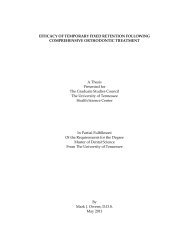Hossam Abdelsamed Abstract - ETD Index Page
Hossam Abdelsamed Abstract - ETD Index Page
Hossam Abdelsamed Abstract - ETD Index Page
Create successful ePaper yourself
Turn your PDF publications into a flip-book with our unique Google optimized e-Paper software.
<strong>Hossam</strong> <strong>Abdelsamed</strong><br />
Document Type:<br />
Name:<br />
Email Address:<br />
Title:<br />
Doctoral Dissertation<br />
<strong>Hossam</strong> <strong>Abdelsamed</strong><br />
hossams2020@hotmail.com<br />
HP TURNS 17: T HELPER 17 CELL<br />
RESPONSE DURING HYPERSENSITIVITY<br />
PNEUMONITIS (HP) AND FACTORS<br />
CONTROLLING IT<br />
Degree:<br />
Major:<br />
Program:<br />
Track, if Integrated Program in Biomedical<br />
Sciences:<br />
Research Advisor:<br />
Advisor's Email:<br />
Committee Members:<br />
Keywords:<br />
Availability:<br />
Doctor of Philosophy<br />
Integrated Program in Biomedical Sciences<br />
Microbial Pathogenesis, Immunology, and<br />
Inflammation<br />
Elizabeth A. Fitzpatrick, Ph.D.<br />
efitzpat@uthsc.edu<br />
David D. Brand, Ph.D.<br />
Fabio C. Re, Ph.D.<br />
Graduation Date: May 2012<br />
Susan E. Senogles, Ph.D.<br />
Christopher M. Waters, Ph.D.<br />
Th17, T-bet, Hypersensitivity pneumonitis<br />
World-Wide Web Access<br />
<strong>Abstract</strong><br />
Hypersensitivity Pneumonitis (HP) is an interstitial lung disease caused by repeated<br />
inhalation of a wide range of environmental antigens. It is characterized by alveolitis, granuloma<br />
formation, and fibrosis. Since HP is a T cell-mediated disease, it is important to determine the<br />
type of T cell response associated with granuloma formation and the factors that control this<br />
response. We hypothesized that HP is associated with a predominant Th17 cell response where<br />
both T-bet and TLRs 2 and 9 are controlling T cell response during HP. The results demonstrated<br />
a predominant Th17 response associated with granuloma formation in the lungs of C57BL/6J
mice during granulomatous and chronic HP. We also found that T-bet KO mice exposed to<br />
Saccharopolyspora rectivirgula (SR) were characterized by exacerbated Th17 cell response<br />
accompanied by an increase in granuloma formation and collagen production in the lungs<br />
compared to WT exposed mice. In an attempt to find other factors regulating Th17 development,<br />
previous studies in our lab showed that TLR2/9 double knockout (DKO) exposed mice were<br />
characterized by a decrease in the percentage of Th17 cells in their lungs compared to WT mice.<br />
Consequently, we hypothesized that the decrease in Th17 response is attributed to defect in<br />
phagocytosis, or cytokines production, or antigen presentation ability of TLR2/9 DKO antigen<br />
presenting cells (APCs). In vitro, we found no significant difference in the phagocytosis ability<br />
of both WT and TLR2/9 DKO BMDMs (Bone Marrow Derived Macrophages) or BMDCs (Bone<br />
Marrow Derived Dendritic Cells). In vivo, there was no significant difference in the phagocytosis<br />
ability of both WT and TLR2/9 DKO alveolar macrophages. Although we found that both TLRs<br />
2 and 9 were regulating cytokine production e.g. IL-6, IL-10, and TNFα from BMDMs, we did<br />
not find a defect in antigen presentation ability of both WT and TLR2/9 DKO splenic APCs. In<br />
conclusion, these findings suggested the following: (1) Both granulomatous and chronic HP is<br />
associated with a predominant Th17 response and granuloma formation; (2) T-bet plays a role in<br />
controlling disease severity and Th17 development during HP; (3) TLR2 and 9 do not affect<br />
APCs’ ability to phagocytose SR but they affect cytokine production; and (4) Both WT and<br />
TLR2/9 DKO APCs are equally efficient in presenting SR antigen to T cells.<br />
Attached File(s)<br />
pdf (2.0 Mbytes). This pdf best viewed using the latest version of Acrobat Reader. .<br />
| Back to <strong>ETD</strong> <strong>Index</strong> <strong>Page</strong> | Back to CGHS Home <strong>Page</strong> |<br />
Revised 02 May 2012
















